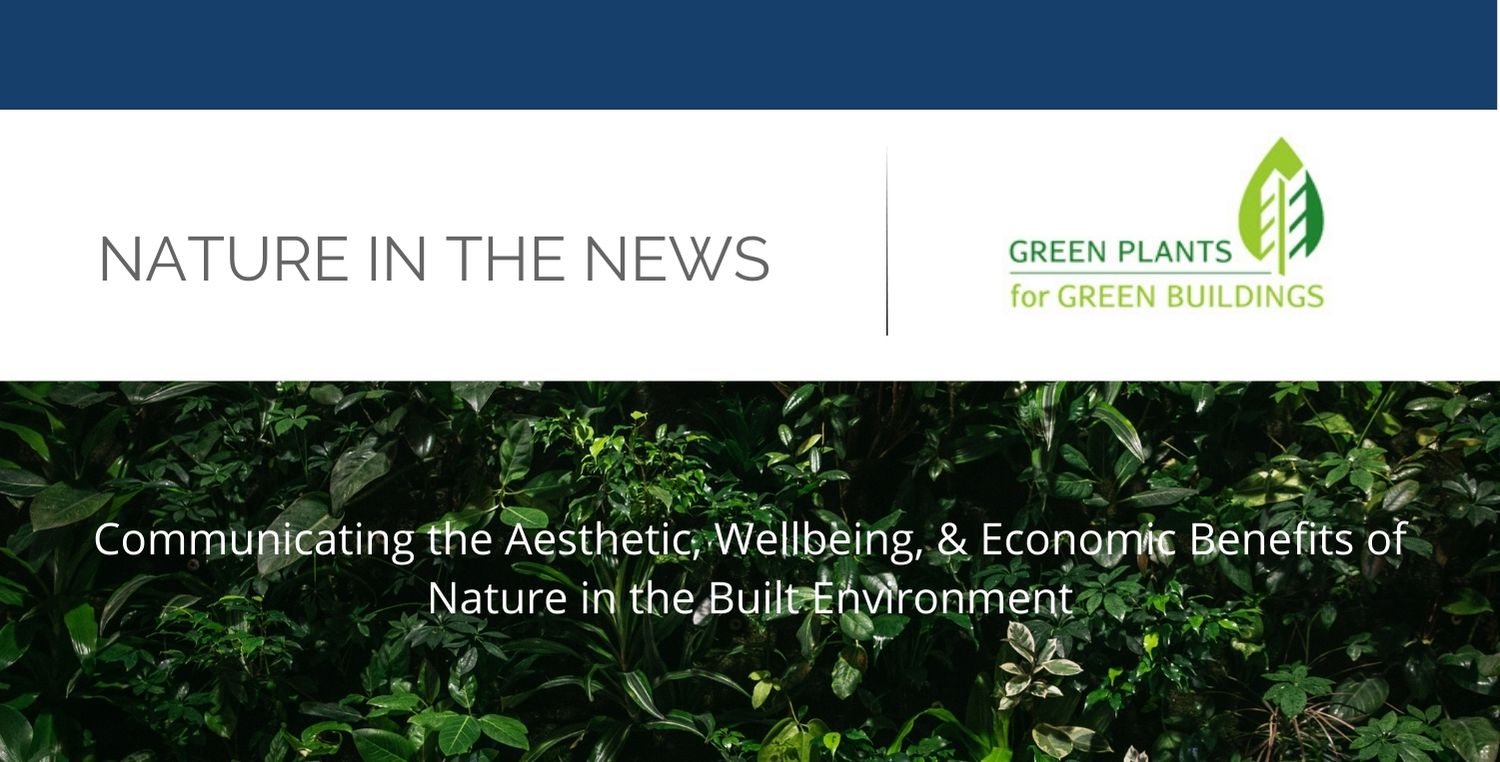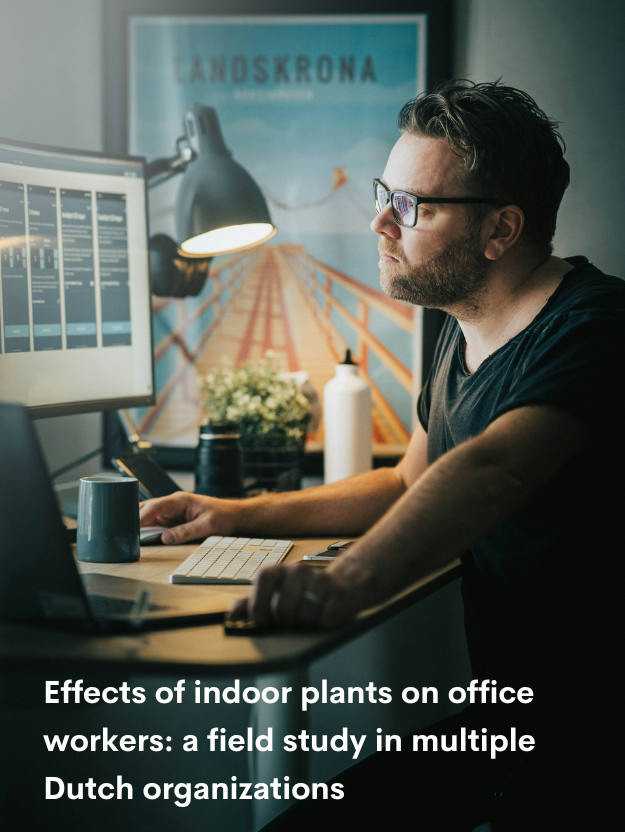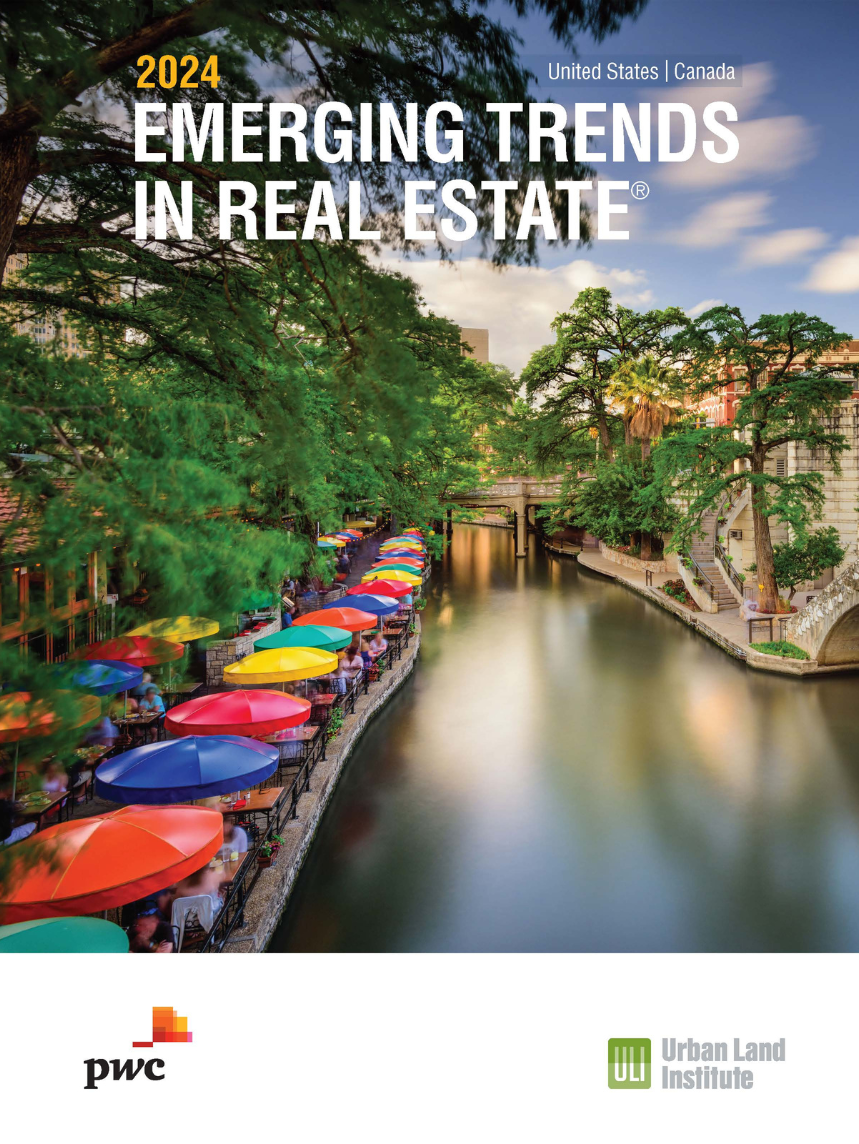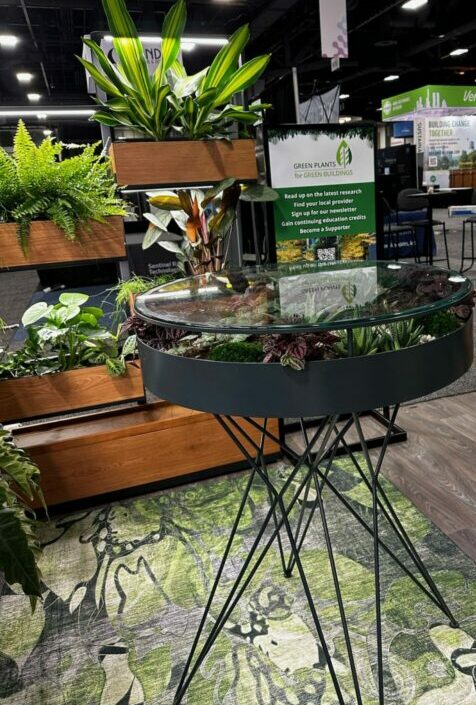
This e-newsletter brings you the latest information and resources on biophilic design, the industry, and GPGB updates.
Effects of Indoor Plants on Office Workers: A Field Study in Multiple Dutch Organizations

Credits: Frontiers in Psychology
Article Type: Original Research
Published: 28 June 2023
DOI 10.3389/fpsyg.2023.1196106
In the period 2019–2020, the effect of plants in the workspace on (a) the physical indoor climate, (b) the perception of the workspace by office workers, and (c) their health, well-being and functioning was investigated in nine organizations. This paper reports the outcomes of the latter part. A conceptual model describing the short-term, medium and long-term effect of plants on people was formulated, containing 18 outcome variables. A “Before After Control Impact” quasi-experimental research design was used. A control workspace and an intervention workspace were selected in each of the organizations. A pre-measurement was conducted in both. Correlational analyses, based on the pre-measurements in all organizations and workspaces, confirmed the associations proposed by the conceptual model to a large extent. After placing plants in the intervention workspace, a maximum of two post-intervention measurements were conducted (due to COVID-19 not in all nine organizations), the last one at least 4 months after the introduction of the plants.
Overall significant effects were found on complaints about dry air (fewer), the sense of privacy (higher), the attractiveness of the workspace (higher), satisfaction with the workspace (greater) and having a health-related complaint, especially when at work (fewer). The first three effects were already observed in the analyses only including the first post-measurement. The latter two effects only showed up in the analyses including two post- measurements. No direct effect of the plants could be demonstrated on the 13 other outcome variables. The observed effects mainly concern outcome variables that are positioned at the beginning of the proposed causal chain, starting with plants and ending with mental health, absenteeism and job satisfaction.
Emerging Trends in Real Estate® 2024

Credits: PwC and Urban Land Institute
Emerging Trends in Real Estate® is a trends and forecast publication now in its 45th edition, and is one of the most highly regarded and widely read forecast reports in the real estate industry. Emerging Trends in Real Estate® 2024, undertaken jointly by PwC and the Urban Land Institute, provides an outlook on real estate investment and development trends, real estate finance and capital markets, property sectors, metropolitan areas, and other real estate issues throughout the United States and Canada.ng pot completed in 2022. Amid a densely residential area dominated by mid and high rises properties, the firm has created what it describes as an “urban terrarium prototype” based on the natural relationships between mountainous, woodland and river ecosystems. Having repurposed a podium structure, these environments are spread over the foot and mezzanine levels of a huge condominium. Mid-height and rooftop gardens also feature, installed into the fabric of the building itself, incorporating open greening, sports and recreational areas, swimming pools, and a sky forest. The emphasis is on (re)introducing a breadth of flora and fauna to reflect the heterogeneity of South East Asia’s rich wildernesses…
GPGB Shines at AIA24: A Step Towards a Greener Future

Credits: Planter Trends Monthly Newsletter
Published June 8, 2024 by Jean-Pierre Sijmons, Architectural Supplements
Green Plants for Green Buildings (GPGB) recently significantly impacted the AIA Conference held in Washington, D.C. As a gold sponsor, GPGB showcased its commitment to promoting biophilic design and the integration of natural elements into built environments. GPGB’s presence at the conference highlighted its mission and demonstrated the growing importance of sustainable practices in architecture and urban planning.
Creating a Green Oasis
GPGB transformed a section of the conference into a verdant oasis, drawing attendees into a serene and inspiring space. This installation served as a living example of the benefits of incorporating green plants into building designs. The lush greenery provided a refreshing contrast to the convention hall’s typical setup, emphasizing how nature can enhance indoor environments.
Engaging Speaker Lineup…
The Importance of GPGB’s Mission…
Volunteer Efforts…
Looking Ahead…
Your Investment At Work

GPGB created an amazing opportunity to have supporter companies recognized at AIA24 with thousands of attendees.
GPGB had record high visits to the website and social media!
On site, QR codes were posted for attendees to:
- Find a local provider
- Reach a Registered Trainer/Book a CEU
- Calculate the ROI at your facility
- View Resource Library
- Discover Projects in the Gallery
- Become A Supporter
- Review the Research
- Newsletter Signup
Don’t miss out! Ensure your GPGB support is active and/or level-up today!
Women Entrepreneurs: Trends in Plantscape Design, Tech, Products, and Holiday Decor

Sunday, July 14 • 2:30 PM – 3:30 PM Eastern Time (US & Canada)
At Cultivate’24, July 13-16, 2024, Greater Columbus Convention Center, Columbus, OH
GPGB supporter, Rebecca Bullene and Founder of Greenery NYC will enlighten on the newest, coolest Plantscaping products that will change the future of the Plantscaping indutstry.
Fellow GPGB Supporter, Rebecca Bakke and Owner of Bloom and Flourish, will discuss the latest interior botanical designs.
Caroline Puller VP of Visual Design of Seasonscapes will give a world tour of the International Christmas show she recently attended in Germany.
GPGB President, Jan Goodman and Founder of Cityscapes Boston will excite all with the newest opportunities in additional revenue streams for your business. They will also discuss living art, foodscaping, living fernature, plant parties/pop-ups, and immersion rooms.
Call to Action: Support and/or “Level-Up” with GPGB

Our purpose is to communicate the aesthetic, wellbeing, and economic benefits of nature in the built environment.The target audience is the commercial specifier, building owner, facility manager and related decision makers.
Thanks to our supporters, we have been extremely successful in reaching our audience. There is unparalleled awareness of the economic benefits of interior plants and more plants are being specified in building projects than ever. The industry has never been stronger. We want to capitalize on our momentum and assure plants become a permanent element in commercial design.
GPGB is asking for increased support. GPGB has just completed an overhaul of our supporter tiers and added new benefits at each level. As important as the benefits are, the primary reason to support is to help us influence more decision makers on the benefits of plants, and ultimately grow the industry, and grow your business.
Thank you to the following companies for joining GPGB:
–Austin Moss Creations LLC
–BioFiliate
–Frida’s
–Greenworks, Inc.
–Habitat Horticulture
–LooXo
–MacBeth Farm Interiorscapes Philadelphia
–Nature Matters KC
Thank you to the following companies for “leveling-up” with GPGB:
Continued Education Units

Educate, Advocate, and Empower with GPGB courses!
It is increasingly well documented that biophilic elements such as live plants in buildings have measurable benefits to productivity, emotional wellbeing, stress reduction, and improved learning and healing.
The inclusion of biophilic design elements into building standards (the WELL Building Standard, Fitwel, the Living Building Challenge, LEED) is creating an even greater need for biophilic design information.
As part of GPGB’s core purpose is communicating the aesthetic, wellbeing, and economic benefits of nature in the built environment, we create courses credentialed for continuing education credit by the professional organizations listed below.
These courses contain important research-based information about the biophilic design ethic’s contributions to human health, safety, and welfare, as well as practical information about how to specify indoor nature in the built environment.
- Book a CEU
- Become a Registered Trainer
- Purchase a CEU at $225 each or bundle and save-
- Receive ALL GPGB slide decks for $495
➡️ Stay tuned for the release of the newest CEU, “Nature’s Blueprint: Unleashing the Power of Biophilic Design”.
Biophilic design principles and real-world applications to inspire and connect us to the natural world. Delve into the science behind biophilia and learn practical strategies for seamlessly integrating nature into the built environment.
This presentation will explain the impact that Biophilic Design has on human health and well-being by harnessing its transformative potential. From biophilic principles to real-world applications, we will provide a roadmap for creating spaces that inspire, rejuvenate, and connect us to the natural world. This course is fitting for all, whether you’re a seasoned professional or a curious beginner!
Volunteers Wanted for Committees and Board of Directors
GPGB depends on the work of volunteers to carry out our strategic initiatives and fulfill our mission. Serving on a committee or as a GPGB board member is a rewarding experience and an opportunity for personal and professional growth. If you can make a minimum two-year commitment, the industry needs people like YOU!
- Marketing & Communications
- Supporter Development
- Education & Professional Development
Thank You to Our Supporters!
GPGB is making a difference and it’s all thanks to our valued supporters. Our supporter’s participation and contribution is greatly appreciated not only by us, but by everyone in the industry.
Thank you for continuing to add your voice to the hundreds of other industry professionals committed to integrating plants into our built environments. We appreciate your understanding and willingness to “Level-Up” this year!
Continued Supporter Call To Action: Please continue to add your reels, shorts, stories, and all other 15-30 second videos related to biophilia here in order to be featured on GPGB social media.
Biophilic Gallery

Credit: Architizer
Firm: Carazo Arquitectura
Type:Educational › University
Status: Concept
Size:1000 sqft – 3000 sqft
Budget: $1M – 5M
Universidad Latina De Costa Rica, with the mission of having innovative, iconic, and top-level infrastructure, held a private contest to develop its new building at the main campus in San Pedro. From our perspective, the iconic goes hand in hand with innovation, sustainability, the creation of biophilic environments, and in this specific case, the creation of an educational space with a vision for the future. With this end in mind, a dynamic project is proposed, with multi-use spaces that offer students different study environments adapted to the digital and multidimensional world.
Mass Timber
This innovative proposal will be the first large-scale building in Costa Rica with its entire structural system in composite wood (mass timber); integrating last generation laminated wood and CLT.
We see composite wood as the material for the future, as it is a regenerative natural resource, recyclable, and contributes to carbon fixation and ecological regeneration. By using wood as the primary material, the project is outlined as a campus oriented towards the future.
We propose to make an immediate jump to this innovative construction system, without waiting for the usual speed with which construction technologies reach our countries. Using this construction system means taking a technological leap, from the development of small buildings and houses to the construction of a large-scale academic institutional building with a challenging and unique structural expression.

Photo and Credits: Amusement Logic
NatuRestaurant: A dining experience that combines contemporary interior design with the serenity of nature.
It is a trend in the interior design of modern restaurants to adopt an architecture of fluid forms populated with plant elements. This creates a natural and welcoming environment for diners. In Amusement Logic’s Design Department, we are working on a biophilic restaurant, or NatuRestaurant, which joins this trend.
Curved walls and sinuous ceilings are complemented by hanging plants and vertical gardens. These green ‘guests’ not only beautify the space, but also improve air quality and promote well-being. After all, plants and nature in general are known to have a positive effect on people’s moods. Soft lighting finally enhances the natural textures and therefore contributes to the benign atmosphere.
Otherwise, this restaurant of ours, with its biophilic interior design and abundant green surfaces, promotes sustainability through the use of eco-friendly materials and practices. The result is a dining experience that combines contemporary interior design with the serenity of nature.
By Manuel Devesa, Senior Architect at Amusement Logic Design Dept.
Want to Help Keep Nature in the News?
 Everything we accomplish happens because people like you are stepping forward and supporting GPGB’s focus on having conversations with the building professionals who can #BringNatureIndoors.
Everything we accomplish happens because people like you are stepping forward and supporting GPGB’s focus on having conversations with the building professionals who can #BringNatureIndoors.
If the spirit moves you, please consider supporting our work by making a donation.
